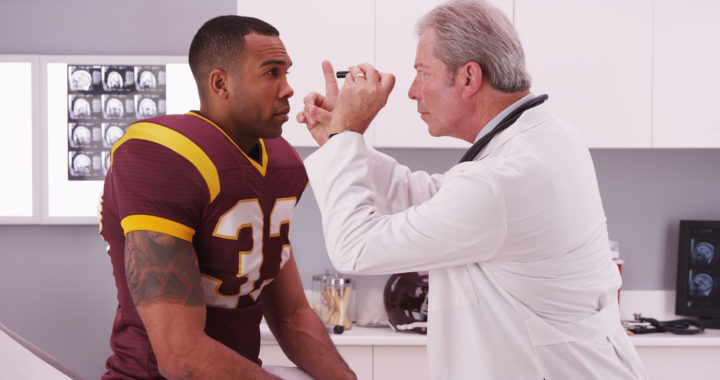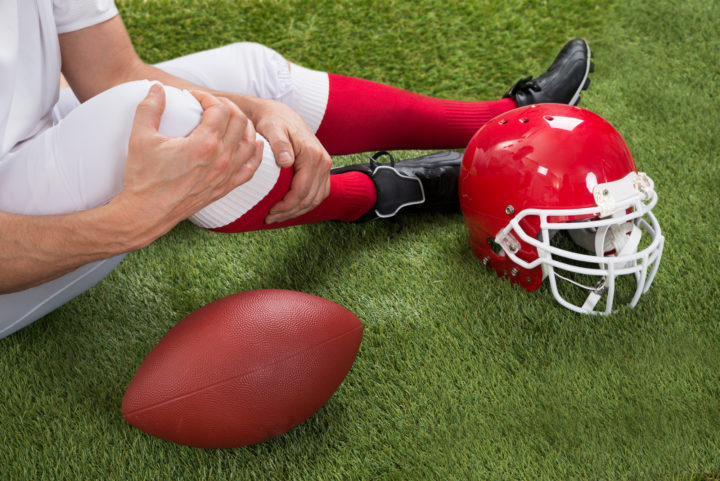Injury Time: Understanding Common Football Injuries
posted by Stacie on September 24, 2023
// Comments Off on Injury Time: Understanding Common Football Injuries
Football's brilliance is undeniable, but its dangers are real. Injuries, from minor bumps to life-altering events, are a common downside. However, since football is a full-contact, high-speed, and aggressive game, some injuries are inevitable.
The good news? We can take steps to reduce their likelihood. Let's explore some of the most common football injuries, along with strategies for preventing and managing them. Keep reading to become more informed about keeping yourself (or your favorite player) safe on the field!

Image from Depositphotos
Sprains & Strains
On the minor end, you will find that ankle sprains are common in football. Additionally, muscle strains are easy to sustain in a game of football. These injuries can come from many situations, including sudden movements, changing of direction at fast speeds, and collisions. Although minor, these injuries can be painful, and a full recovery must be made before playing again.
ACL Tears
ACL tears are another common injury and one that can be incredibly painful and difficult to recover from. You will often find that a player is never quite the same after suffering an ACL tear, as they can be so difficult to recover from and often require surgery. These injuries tend to occur when a player twists their knee. Consult with a McKinney Shoulder Surgeon to find out how to proceed with this type of injury.
Family Safety For All Generations
Achilles Tendonitis
Another injury that is common in football is Achilles tendonitis, which often develops from sprinting at high speeds (this is a common injury in many sports). Essentially, this is the inflammation of the Achilles tendon, which can cause a great deal of pain and discomfort. Any injury involving the Achilles can also take a long time to recover from, especially as it is so difficult to rest.
Achilles tendonitis treatment involves physical therapy to strengthen muscles and address biomechanical issues, with additional support provided by orthotic devices. Calf stretches and exercises help alleviate tension. Gradual return to activity is advised under professional guidance. Platelet-rich plasma (PRP) therapy or corticosteroids may be considered for inflammation.

Image from Depositphotos
Spinal Cord Injuries
One of the most severe injuries that can be sustained in football involves spinal cords. Spinal cord injuries can occur from high-impact collisions that lead to force to the head, neck, or back. The severity of these injuries can vary, but they are often life-changing and can require the use of a wheelchair. This is why it is so important that safe tackling is taught from a young age.
The good news is that there have been some amazing breakthroughs in spinal cord injury treatment in recent times. Cell therapy can help those who previously thought recovery was not possible to lead a more active lifestyle. This amazing treatment can promote healing in the spinal cord, improve sensory and motor function, reduce inflammation, and increase muscle strength. This treatment is available through stem cell therapy experts like bioxcellerator.com.
The prognosis for spinal cord injury varies based on factors like injury severity, location, and individual health. Outcomes range from total loss (complete injuries) to retained function (incomplete injuries). Medical complications, rehabilitation, and support impact prognosis. A multidisciplinary approach is vital for optimizing long-term outcomes and quality of life for individuals with SCI.

Image from Depositphotos
Concussion
Concussion is a major talking point in football (and many other sports). Helmet-to-helmet collisions can lead to concussions and serious injuries. Any player who has a head injury must be checked over by a professional and return-to-play protocols are followed carefully.
Finding one of the most dependable concussion clinics near you is crucial. Emphasize adherence to strict return-to-play protocols, education for players and stakeholders, and ongoing monitoring. Verify insurance acceptance or obtain clear cost information for accessible care. These considerations ensure a reliable clinic that prioritizes player safety and supports a smooth recovery process.
Managing a concussion at home involves prioritizing rest, refraining from intense activities, and excessive screen time. Adequate sleep is crucial. Monitor headaches, dizziness, and mood changes. Stay hydrated, maintain a balanced diet, and use recommended pain relievers. Minimize stimuli, communicate for support, and avoid alcohol and drugs during recovery. Gradually reintroduce daily activities under professional guidance, avoiding strenuous physical activities without clearance.
These are a few of the most common injuries that are sustained in football. It is important to be aware of these injuries and how they can be both avoided and managed to fully enjoy the great game.
7 Ways Your Loved Ones Can Help You After a Personal Injury
Comments Off on Injury Time: Understanding Common Football Injuries







